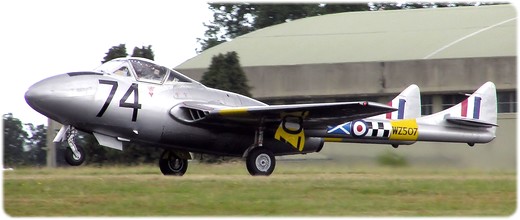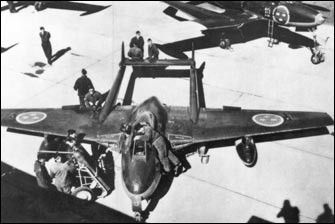 |
de Havilland DH-100 Vampire
From the beginning the Vampire was an experimental military aircraft, with quite a few groundbreaking characteristics. Work on it began during World War Two, but it was never put to use before the war ended. Later it became a big success in many countries and served for many years in, for example, the Swedish Air Force.
[ Top of page ]
History
Only two years after the Royal Air Force's first jet aircraft, Gloster Meteor, de Havilland in 1942 started working on the Vampire, or Spider Crab as it was originally called. At this time the new jet engines had improved to such a degree that the Vampire could be built around just one, unlike the Meteor and the German Messerschmitt Me 262 that were using two. This was a new thing to do, and so was the use of a fuselage with twin beams, much like the American P-38. That way the jet pipe became shorter, reducing power loss thanks to the exhaust being straight behind the engine.
For the last time a wood and metal construction was used in a military jet aircraft. de Havilland were experts on this, the classic Mosquito being the most famous example. The Vampire was built from wood from the nose all the way to the engine compartment. This was done mainly for two reasons: the weight of the aircraft was reduced and it was easier to keep the cabin pressurised.
 |
Two Swedish J 28B above dense clouds. |
| J 28B being prepared on the ground. In the background is a Saab J 21R, the first Swedish made military jet aircraft.
Its construction was inspired by the Vampire, to say the least... These pictures are from the SFF archive. |
 |
The first prototype flew on September 30, 1943, with de Havilland's chief test pilot, and its founder's son, Geoffrey de Havilland Jr at the controls. However, the first production version did not fly until April of 1945 and consequently the Vampire never saw combat in World War Two. And due to the pressure on the de Havilland facilities to produce other types, most Vampires were built by English Electric Aircraft. All in all, about 3,200 Vampires were produced through the years.
In 1946, the Swedish Air Force became the first foreign customer to place an order for 70 Vampire FB 1, designated J 28A. A new version - J 28 B - arrived in 1949. Among other improvements it had a larger fuel capacity. These two types served until 1952 when they were replaced by the J 29 Saab Tunnan and J 34 Hawker Hunter. Around the same time, twenty two-seat trainer versions of the Vampire were ordered. For some strange reason that version was designated J 28C and not Sk 28, which would have been consistent with every other trainer in the Swedish Air Force.
In many ways the Vampire broke new ground. It was the first aircraft in the RAF to have a top speed of over 500 mph, it was the first jet aircraft to take off and land on a carrier, and in 1948 a new altitude record of 18,000 meters was set by John Cunningham. And on July 14 of the same year the Vampire became the first jet aircraft to cross the Atlantic.
[ Top of page ]
Video
| J 28C Vampire SE-DXV at an airshow in Ljungbyhed on May 31, 2008. This aircraft never actually served in the Swedish Air Force, it is originally Swiss, but is now owned, taken care of and flown by the Ljungbyhed Aeronautical Society. | |
[ Top of page ]